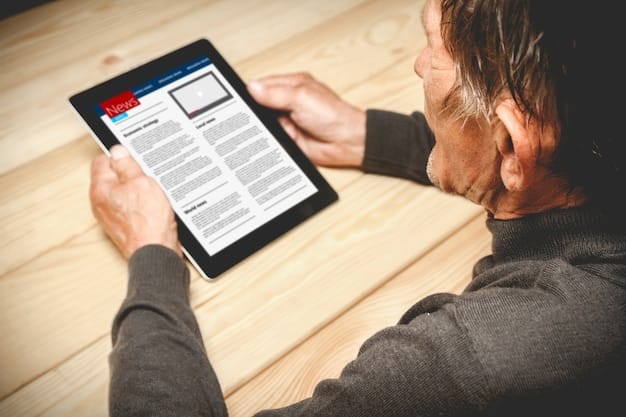LinkedIn Etiquette: Respectfully Building Your Network Online

The Unwritten Rules of LinkedIn Etiquette: How to Build Your Professional Network Respectfully involves understanding unspoken social norms on the platform, crafting a professional profile, engaging thoughtfully in discussions, respecting boundaries, and maintaining a positive and authentic online presence to foster meaningful connections.
Navigating the professional world requires more than just skills and experience; it also demands a solid understanding of etiquette, especially in the digital realm. Let’s explore The Unwritten Rules of LinkedIn Etiquette: How to Build Your Professional Network Respectfully, ensuring you make the right impression and cultivate meaningful connections.
Why LinkedIn Etiquette Matters
LinkedIn is a powerful platform for career advancement, networking, and professional growth. However, its effectiveness hinges on how well you navigate its social norms. Understanding and practicing proper LinkedIn etiquette is crucial for building a strong professional network and making a positive impression.
Adhering to these unwritten rules can significantly enhance your online presence and open doors to new opportunities. Let’s delve into why these practices are essential.
Building a Credible Online Presence
Your LinkedIn profile is often the first impression you make on potential employers, clients, or collaborators. A well-crafted profile that showcases your skills, experience, and professionalism can set you apart from the competition.
- First Impressions: A polished profile signals competence and attention to detail.
- Professional Branding: Consistent branding across your profile enhances credibility.
- Networking Opportunities: A strong profile attracts relevant connections in your field.
Respecting Professional Boundaries
LinkedIn is a professional space, and maintaining respect for others’ boundaries is paramount. Understanding what is appropriate in terms of communication, endorsements, and recommendations helps foster positive relationships.
- Avoid Spamming: Refrain from sending unsolicited messages or connection requests.
- Respect Privacy: Do not share private information without consent.
- Mindful Endorsements: Only endorse skills you genuinely believe the person possesses.
Fostering Meaningful Engagement
Engaging thoughtfully in discussions, sharing valuable insights, and providing constructive feedback can establish you as a knowledgeable and valuable member of your professional community.
- Contribute Value: Share relevant articles, insights, and industry news.
- Engage Respectfully: Offer thoughtful comments and avoid confrontational debates.
- Seek Collaboration: Initiate conversations and collaborations with other professionals.
In conclusion, mastering LinkedIn etiquette is not just about following rules; it’s about building and maintaining professional relationships that can propel your career forward. By understanding and implementing these unwritten guidelines, you can create a strong, credible, and engaging online presence.
Crafting a Professional Profile
Your LinkedIn profile is your digital resume, and it’s crucial to ensure it reflects your professional brand accurately. A well-crafted profile not only attracts attention but also communicates your skills, experience, and values effectively.
Optimizing each section of your profile is key to making a lasting impression. Here are some essential elements to consider.

Profile Picture and Headline
The first things visitors see are your profile picture and headline. These elements should be professional and clearly convey your role and expertise.
- Professional Photo: Use a high-quality headshot with good lighting and a neutral background.
- Compelling Headline: Go beyond your job title to highlight your unique value proposition.
- Consistency: Ensure your photo and headline align with your overall professional brand.
Summary and Experience Sections
The summary and experience sections tell your professional story. These should be detailed, engaging, and tailored to your career goals.
- Engaging Summary: Write a concise and captivating summary that highlights your achievements and career aspirations.
- Detailed Experience: Provide specifics about your roles, responsibilities, and accomplishments in each position.
- Quantifiable Results: Use numbers and metrics to showcase the impact of your work.
Skills and Endorsements
Listing your skills and seeking endorsements from colleagues and connections can enhance your credibility and visibility on LinkedIn.
- Relevant Skills: Include skills that align with your industry and career goals.
- Strategic Endorsements: Request endorsements from colleagues who can vouch for your expertise.
- Balanced Approach: Offer endorsements to others to reciprocate and strengthen your network.
In conclusion, crafting a professional LinkedIn profile is an ongoing process. Regularly update your profile with new skills, experiences, and accomplishments to ensure it remains current and relevant. A well-maintained profile can significantly enhance your professional opportunities and connections.
The Art of Thoughtful Engagement
LinkedIn is not just a platform for showcasing your resume; it’s also a social network where engagement and interaction are highly valued. Engaging thoughtfully can help you build relationships, establish expertise, and expand your professional network.
However, it’s essential to approach engagement with authenticity and respect. Let’s explore how to navigate this aspect of LinkedIn effectively.
Commenting and Sharing Wisely
Your comments and shares reflect your professional brand. It’s crucial to ensure they are insightful, respectful, and relevant to the discussions at hand.
- Insightful Comments: Provide thoughtful and constructive feedback on others’ posts.
- Relevant Sharing: Share articles, insights, and industry news that are valuable to your network.
- Avoid Negativity: Refrain from engaging in negative or confrontational discussions.
Joining and Participating in Groups
LinkedIn Groups are a great way to connect with like-minded professionals, share expertise, and participate in industry-specific discussions. However, it’s crucial to engage in a way that adds value to the community.

- Choose Wisely: Join groups that align with your interests and professional goals.
- Contribute Actively: Share your expertise, ask questions, and participate in discussions.
- Respect Group Rules: Adhere to the group’s guidelines and avoid self-promotion.
Creating and Sharing Original Content
Publishing original content on LinkedIn can establish you as a thought leader in your field and attract attention from potential employers or clients.
- Valuable Content: Share insights, experiences, and expertise that are relevant to your audience.
- Consistent Posting: Regularly publish content to maintain engagement and visibility.
- Engage Feedback: Respond to comments and questions to foster a community around your content.
Engaging thoughtfully on LinkedIn is about providing value, fostering connections, and maintaining a respectful and professional demeanor. By contributing positively to the platform, you can strengthen your network and enhance your career opportunities.
Respecting Boundaries and Privacy
In any professional setting, respecting boundaries and privacy is crucial for maintaining positive relationships. LinkedIn is no exception. Understanding and adhering to these principles can help you avoid missteps and build trust with your connections.
Here are some key considerations for respecting boundaries and privacy on LinkedIn.
Appropriate Connection Requests
Sending connection requests indiscriminately can be off-putting. It’s essential to personalize your invitations and provide context for why you want to connect.
- Personalize Invitations: Add a note explaining why you want to connect and what you hope to gain from the connection.
- Targeted Approach: Focus on connecting with professionals in your field or those who align with your career goals.
- Avoid Mass Requests: Refrain from sending generic connection requests to a large number of people.
Mindful Messaging Practices
LinkedIn messaging should be professional and respectful. Avoid sending unsolicited messages or spamming your connections with irrelevant content.
- Clear Communication: Be clear and concise in your messages, respecting the recipient’s time.
- Professional Tone: Maintain a professional tone and avoid using informal language.
- Avoid Spam: Refrain from sending unsolicited messages or promotional content without permission.
Handling Endorsements and Recommendations
Endorsements and recommendations are valuable on LinkedIn, but they should be genuine and based on firsthand experience. Avoid soliciting endorsements inappropriately or providing dishonest recommendations.
- Genuine Endorsements: Only endorse skills you genuinely believe the person possesses.
- Honest Recommendations: Provide recommendations based on your direct experience working with the person.
- Reciprocal Approach: Offer endorsements and recommendations to others as a way of reciprocating and strengthening your network.
Respecting boundaries and privacy on LinkedIn is about treating others with consideration and professionalism. By following these guidelines, you can build trust and maintain positive relationships with your connections.
Maintaining Authenticity and Positivity
In the age of digital networking, authenticity and positivity can set you apart from the crowd. LinkedIn is a platform where genuine interactions and a positive attitude can help you build lasting relationships and advance your career.
Here are some tips for maintaining authenticity and positivity on LinkedIn.
Showcasing Your True Self
Presenting an authentic version of yourself on LinkedIn can help you attract the right connections and opportunities. Be honest about your skills, experiences, and values.
- Honest Representation: Accurately represent your skills, experiences, and qualifications on your profile.
- Personal Branding: Showcase your unique personality and values in your summary and content.
- Avoid Exaggeration: Refrain from exaggerating or misrepresenting your accomplishments.
Engaging with Sincerity
Engaging with sincerity and empathy can help you build trust and rapport with your connections. Show genuine interest in others’ perspectives and offer support where appropriate.
- Listen Actively: Pay attention to others’ posts and comments, and respond thoughtfully.
- Offer Support: Provide encouragement, advice, or assistance to your connections when possible.
- Show Appreciation: Express gratitude for others’ contributions and support.
Maintaining a Positive Attitude
A positive attitude can make you more approachable and attractive to potential employers or collaborators. Focus on sharing positive insights, celebrating successes, and offering solutions to challenges.
- Positive Insights: Share positive news, insights, and experiences with your network.
- Celebrate Successes: Acknowledge and celebrate your own accomplishments and those of your connections.
- Offer Solutions: Provide constructive solutions to challenges and problems in your industry.
Maintaining authenticity and positivity on LinkedIn is about being genuine, empathetic, and optimistic in your interactions. By embracing these qualities, you can build a strong and supportive professional network.
Navigating Common LinkedIn Pitfalls
Even with the best intentions, it’s easy to make missteps on LinkedIn. Understanding common pitfalls and how to avoid them can help you maintain a professional and effective online presence.
Here are some common LinkedIn mistakes and how to steer clear of them.
Over-Promoting and Self-Serving Content
Constantly promoting your own products, services, or achievements can be off-putting to your connections. Focus on providing value and building relationships rather than self-promotion.
- Value-Driven Content: Share insights, articles, and resources that are relevant and helpful to your audience.
- Balanced Approach: Limit self-promotional content and focus on building relationships.
- Engage, Don’t Just Broadcast: Participate in discussions, ask questions, and offer support to your connections.
Ignoring InMail Etiquette
InMail messages should be used judiciously and respectfully. Avoid sending generic or unsolicited messages and always provide context for your outreach.
- Personalize Messages: Tailor your messages to the recipient and explain why you are reaching out.
- Respect Boundaries: Avoid sending unsolicited messages or promotional content without permission.
- Be Clear and Concise: State your purpose clearly and respect the recipient’s time.
Neglecting Profile Maintenance
An outdated or incomplete LinkedIn profile can make a negative impression. Regularly update your profile with new skills, experiences, and accomplishments.
- Regular Updates: Update your profile with new roles, responsibilities, and accomplishments.
- Skills and Endorsements: Add relevant skills and seek endorsements from colleagues and connections.
- Engaging Summary: Keep your summary current and engaging, highlighting your career aspirations.
Mastering LinkedIn etiquette involves more than just knowing the rules; it’s about understanding the unspoken norms and acting with professionalism, respect, and authenticity. Avoid these common pitfalls to ensure your LinkedIn presence reflects your best self.
| Key Point | Brief Description |
|---|---|
| ✨ Professional Profile | Optimize your profile with a professional photo, headline, and detailed experience. |
| 🤝 Thoughtful Engagement | Engage with insightful comments, relevant shares, and active participation in groups. |
| 🔒 Respect Boundaries | Personalize connection requests and handle messages and endorsements mindfully. |
| 🌟 Authenticity | Showcase your true self, engage with sincerity, and maintain a positive attitude. |
FAQ
▼
LinkedIn etiquette is important because it helps you create a positive professional image, build trust with your connections, and open doors to new opportunities. Following etiquette guidelines ensures you are perceived as respectful and competent.
▼
Improve your LinkedIn profile by using a professional photo, crafting a compelling headline, writing a detailed summary, and showcasing your skills and experience with quantifiable results. Regularly update your profile to keep it current.
▼
Common mistakes include over-promoting your own content, ignoring InMail etiquette, neglecting profile maintenance, and sending generic connection requests. Focus on providing value and building genuine relationships to avoid these missteps.
▼
Engage in LinkedIn Groups by choosing groups that align with your interests, contributing actively with relevant insights, and respecting the group’s rules. Avoid self-promotion and focus on providing value to the community.
▼
The best way to handle connection requests is to personalize your invitations, explaining why you want to connect and what you hope to gain from the connection. Target your requests to relevant professionals and avoid sending mass requests.
Conclusion
Mastering LinkedIn etiquette is essential for building a strong and effective professional network. By understanding and adhering to the unwritten rules of engagement, respecting boundaries, and maintaining authenticity and positivity, you can create a positive online presence and open doors to new opportunities. Remember to always strive for genuine interactions and provide value to your connections, and your efforts will undoubtedly pay off in the long run.





